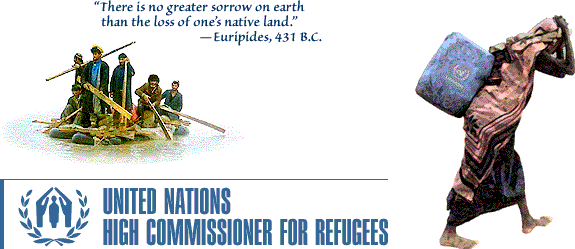June 25, 1991:
Croatia and Slovenia proclaim independence
from the Socialist Federal Republic of Yugoslavia. War begins immediately and rebel Serbs
backed by the Yugoslav army overrun 30 percent of Croatia’s territory. October 8, 1991:
Yugoslavia asks for UNHCR’s assistance
and two weeks later the U.N. Secretary-General designates the organization as the lead
humanitarian agency in the crisis.
January 2, 1992:
The Sarajevo Accord establishes the first
lasting cease-fire in the war in Croatia.
January 15, 1992:
The European Community recognizes the
independence of Croatia and Slovenia.
February 21, 1992:
The U.N. Security Council authorizes the
deployment of the U.N. Protection Force (UNPROFOR) in Croatia. It is later deployed to
Bosnia as well.
March 3, 1992:
Bosnia and Herzegovina proclaims
independence. Bosnian Serbs lay siege to the capital, Sarajevo and seize 70 percent of the
country’s territory
July 3, 1992:
UNHCR Sarajevo airlift, which eventually will
become the longest-running humanitarian airbridge in history, gets underway. At the height
of the conflict in the following two years UNHCR and other agencies assist as many as 3.5
million people throughout the former Yugoslavia. An estimated 700,000 Bosnian refugees
flee and another two million people are internally displaced.
January 11, 1993:
Peace talks on the Vance-Owen plan start in
Geneva.
February 27, 1993:
Airdrop operations began to provide
assistance to besieged enclaves.
May 6, 1993:
U.N. Security Council Resolution 824 declares
Sarajevo, Tuzla, Zepa, Gorazde, Bihac and Srebrenica as ‘safe areas’ but the
military situation on the ground remains unchanged. |
July 11, 1995:
Srebrenica falls to Serb forces setting the
stage for the massacre of thousands of persons in the worst single atrocity in Europe
since World War II. August 12,
1995:
Croatia launches Operation Storm and retakes
the Krajina area from rebel Serbs. 170,000 Serbs flee.
November 21, 1995:
Dayton Peace Agreement covering the end of
hostilities and the return of refugees to Bosnia and Herzegovina is initialled and one
month later the NATO-led Implementation Force deploys to the region.
January 9, 1996:
The longest humanitarian airlift in world
history which fed Sarajevo for 3 1/2 years, ends.
September 14, 1996:
Bosnia and Herzegovina’s first post war
elections confirm wartime hard-line leaders in power, dashing hopes for a speedy return of
refugees.
January 15, 1998:
Eastern Slavonia, captured by the Yugoslav
army in the early part of the war returns to Croatian sovereignty following the departure
of the U.N. Transitional Authority (UNTAES).
March, 1998:
Fighting erupts in Serbia’s Kosovo
province between Albanian separatists and Yugoslav forces, setting off a new wave of
displacement. By September 350,000 people have fled abroad or become internally displaced.
October 27, 1998:
Yugoslav President Slobodan Milosevic bows to
NATO military pressure and agrees to a cease-fire and a partial pull-out of Yugoslav
military and police forces from Kosovo. The Organization for Security and Cooperation in
Europe (OSCE) sends the first of 2,000 verifiers to monitor the agreement.
February 23, 1999:
Tentative agreement on substantial autonomy
for Kosovo reached in Rambouillet, France. |
 Chronology
of the Kosovo Crisis. Published in UNHCR Rising from the ashes?
1999 - a year of decision in the Balkans
Chronology
of the Kosovo Crisis. Published in UNHCR Rising from the ashes?
1999 - a year of decision in the Balkans  Chronology
of the Kosovo Crisis. Published in UNHCR Rising from the ashes?
1999 - a year of decision in the Balkans
Chronology
of the Kosovo Crisis. Published in UNHCR Rising from the ashes?
1999 - a year of decision in the Balkans  Document compiled by Dr S D Stein
Document compiled by Dr S D Stein